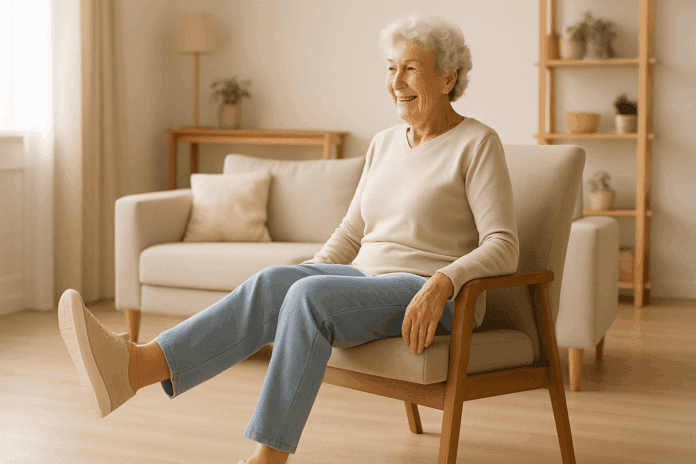Living with arthritic knees or the more advanced condition of bone-on-bone joint degeneration presents daily physical challenges that can gradually erode one’s independence, comfort, and confidence. For many individuals, particularly older adults or those with limited mobility, finding an effective, sustainable method to strengthen the knee joint without aggravating symptoms is crucial. Chair-based exercises offer an ideal solution. Designed to minimize strain on the knees while still engaging key muscle groups, these exercises support joint health, enhance flexibility, and help preserve mobility. Understanding the science behind these movements and implementing them consistently can make a profound difference in quality of life.
You may also like : Best Stretches for Sore Legs and Tight Thigh Muscles: How to Relieve Upper Leg Pain Safely and Naturally
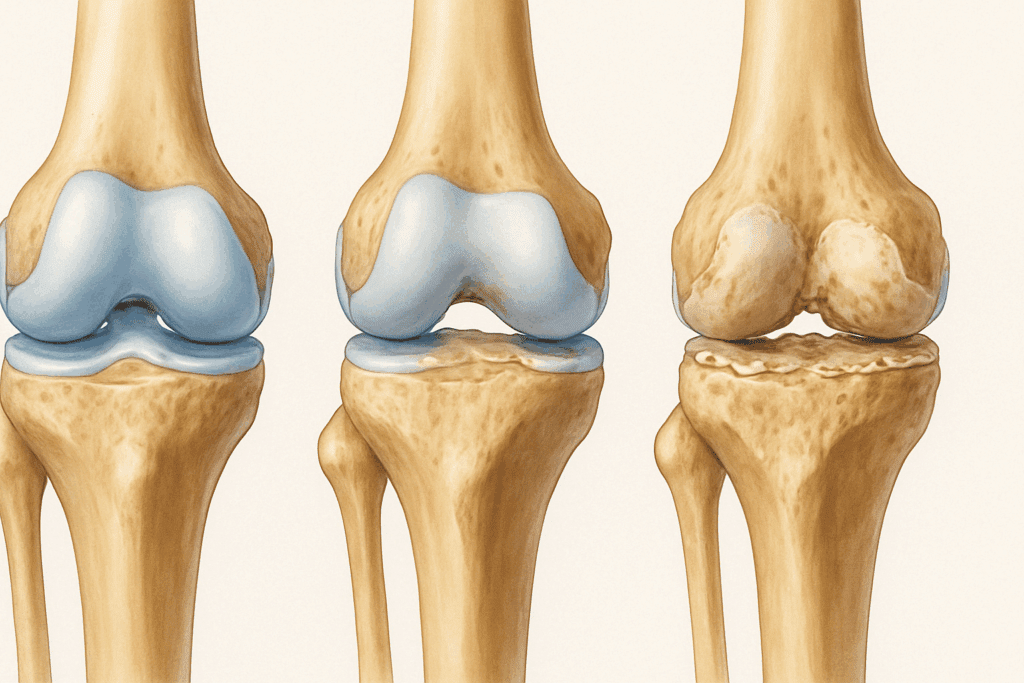
Understanding Knee Arthritis and Bone-on-Bone Pain
Knee osteoarthritis is a degenerative joint disease marked by the breakdown of cartilage—the smooth, protective tissue that cushions the bones where they meet at the joint. As this cartilage wears away over time, bones can begin to rub directly against one another, leading to what is commonly referred to as “bone-on-bone” knee pain. This condition is often accompanied by inflammation, stiffness, reduced range of motion, and sharp or aching pain that intensifies with movement or weight-bearing activity. While the progression of arthritis varies from person to person, once the cartilage is severely damaged or lost, everyday activities such as walking, bending, or standing for prolonged periods can become difficult or even impossible without pain.
For those with severe osteoarthritis, surgery may be recommended, but many individuals are either not ready for surgical intervention or prefer to pursue conservative management strategies for as long as possible. Among these strategies, exercise stands out as a clinically endorsed approach to maintaining joint function. The paradox, however, lies in the nature of movement itself: physical activity can improve joint strength and flexibility, but certain exercises may exacerbate pain if performed incorrectly or without support. This is where chair exercises for arthritic knees prove especially beneficial, offering a controlled and supportive environment to safely engage the muscles without compromising the joint.
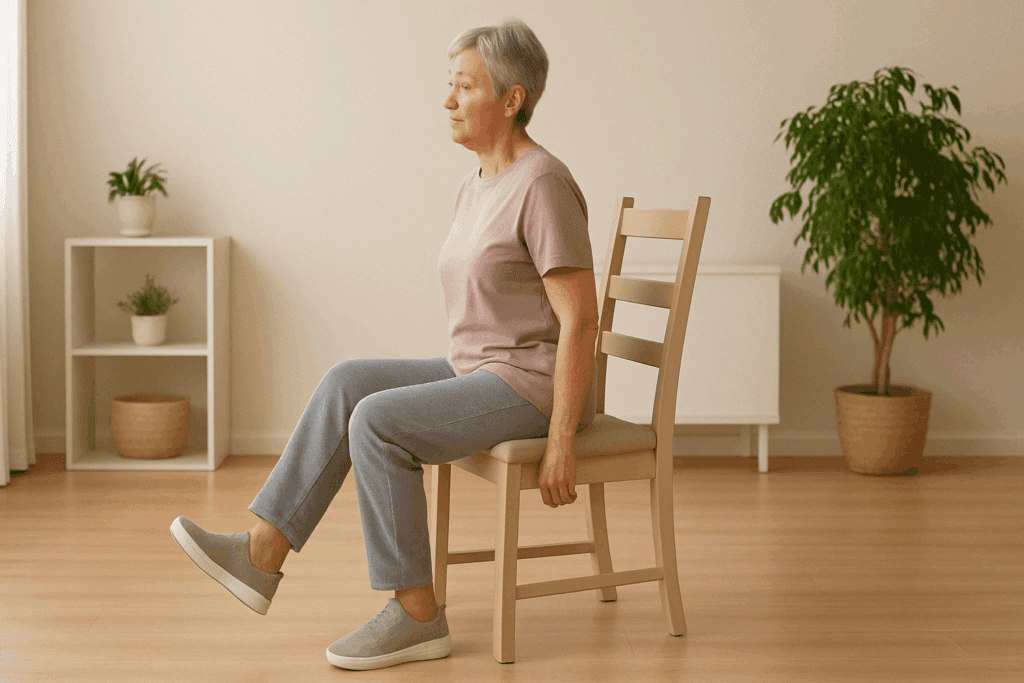
Why Chair Exercises Work for Arthritic and Bone-on-Bone Knees
Chair-based exercises are uniquely suited to individuals with knee osteoarthritis or advanced cartilage loss because they reduce the gravitational load placed on the knees. When performed correctly, these exercises allow participants to remain seated while isolating and strengthening key muscles, particularly the quadriceps, hamstrings, and calves—all of which play a critical role in supporting the knee joint. This form of low-impact movement helps build stability around the knee without contributing to joint deterioration.
Moreover, chair exercises improve circulation in the lower extremities, which can help reduce inflammation and alleviate the stiffness that often accompanies arthritis. Gentle, repetitive motion encourages synovial fluid movement within the joint capsule, effectively lubricating the joint and enhancing mobility. Over time, consistent chair-based activity can also help retrain the neuromuscular system, improving balance, proprioception, and overall coordination. These improvements collectively translate into better performance of everyday activities and a reduced risk of falls or further joint injury.
Importantly, chair exercises are adaptable. Whether someone is newly diagnosed or coping with long-term bone-on-bone knee degeneration, these movements can be scaled in intensity and complexity to match the individual’s functional capacity. This makes them an ideal therapeutic tool not only in physical therapy clinics but also in home fitness routines for aging adults seeking autonomy and safety.

Neuromuscular Re-education and Brain-Body Connection
Neuromuscular re-education refers to the process of training the nervous system to improve communication with muscles, thereby enhancing movement efficiency and coordination. In the context of arthritic knees and bone-on-bone degeneration, this becomes particularly important, as chronic pain and disuse can disrupt normal movement patterns. When knee motion becomes restricted, proprioceptive feedback—the body’s sense of joint position and movement—is often diminished.
Chair-based balance drills, such as seated weight shifts or alternating leg lifts with eyes closed, can gently challenge the nervous system and promote better coordination. Visualization techniques, such as mentally rehearsing the movement before performing it, can further engage the brain and optimize motor control. This mind-body approach is often used in physical therapy settings and is increasingly recognized for its role in restoring function and reducing injury risk.
Adding mindful movement practices, such as chair yoga or seated Tai Chi, enhances this connection. These modalities emphasize slow, controlled motion, breath awareness, and alignment, all of which help retrain the nervous system and restore confidence in movement. For individuals with a history of falls or movement avoidance, this type of practice may be particularly transformative.
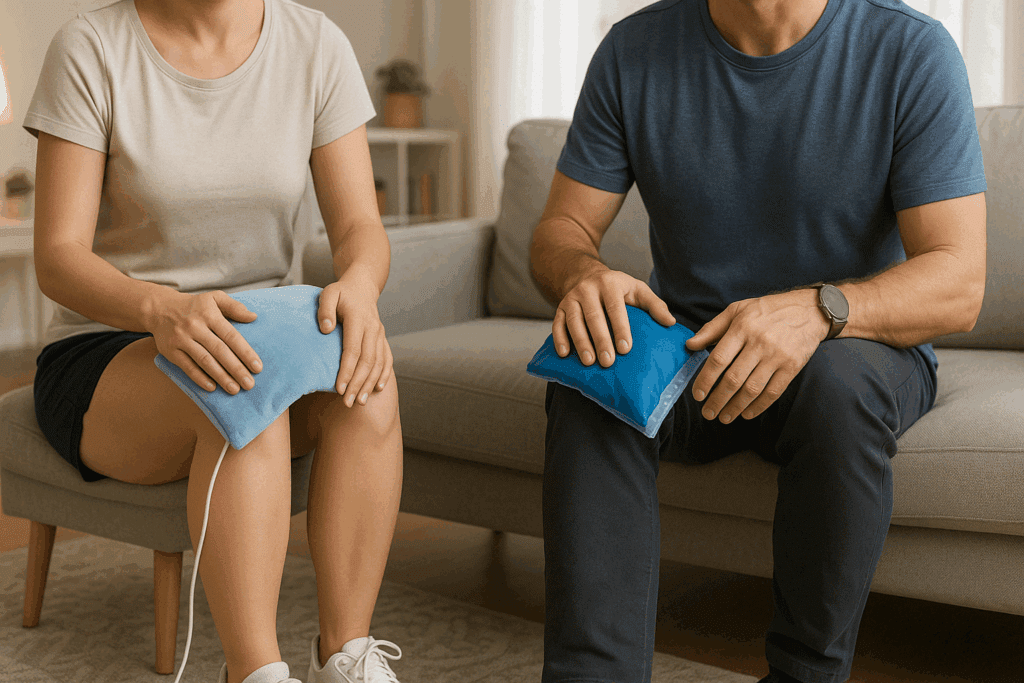
Exploring Heat, Cold, and Topical Pain Relief Techniques
Integrating thermal therapies with chair-based exercise can enhance comfort and function, particularly for individuals dealing with persistent stiffness or pain. Heat therapy, applied before exercise, helps increase blood flow to the muscles and joints, reducing stiffness and preparing the body for movement. Moist heating pads, warm towels, or paraffin wax baths can be safely used for 15 to 20 minutes before beginning chair exercises.
Cold therapy, in contrast, is often used after activity to reduce inflammation and numb soreness. Ice packs or cold compresses applied to the knee for 10 to 15 minutes can help alleviate discomfort following exercise sessions. Alternating heat and cold, known as contrast therapy, may also be effective for certain individuals.
Topical analgesics such as menthol or capsaicin creams can provide temporary relief by stimulating nerve endings and blocking pain signals. These products are often used alongside oral pain medications or as an alternative for those who prefer non-systemic options. As with any treatment, it is important to follow safety guidelines, avoid applying heat to areas with reduced sensation, and consult a healthcare provider before initiating new therapies.
The Role of Assistive Devices in Supporting Exercise and Mobility
While chair exercises for arthritic knees provide a low-impact foundation, some individuals may benefit from the short-term or long-term use of assistive devices to reduce strain during everyday activities. Canes, walkers, knee braces, and orthotic inserts can help redistribute forces across the joint, improving alignment and reducing pain during transitions such as standing up or walking short distances.
For example, a hinged knee brace can provide medial-lateral support and improve confidence during movement. Similarly, cushioned shoe inserts with arch support may reduce pressure on the knees by promoting better gait mechanics. Using these tools in conjunction with chair exercises can create a more supportive environment for recovery and mobility training.
However, it is important to strike a balance. Over-reliance on assistive devices without addressing the underlying muscular deficits can lead to dependency and further deconditioning. Therefore, any use of support devices should be combined with an active strengthening and mobility program that gradually builds confidence and independence.
Psychological and Emotional Dimensions of Chronic Knee Pain
Living with chronic knee pain, especially from bone-on-bone degeneration, can take a toll on one’s emotional well-being. Feelings of frustration, anxiety, or depression are not uncommon, particularly when pain interferes with daily routines or social interactions. Addressing the psychological aspects of pain is essential to ensure long-term success in any exercise or rehabilitation program.
Chair-based movement, by offering a sense of accomplishment and autonomy, can positively impact mental health. Exercise promotes the release of endorphins and neurotransmitters such as serotonin and dopamine, which elevate mood and reduce the perception of pain. Engaging in movement, even when seated, can also counteract the social isolation often experienced by individuals with mobility limitations.
In addition to physical activity, mindfulness meditation, cognitive-behavioral therapy (CBT), and supportive counseling can help individuals reframe their relationship with pain and develop healthier coping mechanisms. Group classes or support networks, whether virtual or in-person, provide a valuable sense of community and motivation. A holistic pain management strategy that acknowledges the emotional and mental toll of arthritis is often more successful and sustainable over the long term.
Getting Started Safely: Precautions and Preparations
Before beginning any new exercise program, especially for individuals with joint degeneration or chronic pain, it is essential to consult with a healthcare provider. A physical therapist, orthopedic specialist, or physician familiar with your condition can help determine which movements are appropriate and whether any modifications are necessary. Once cleared for activity, it is important to begin with realistic expectations and a focus on proper technique rather than intensity.
Choose a sturdy chair with a straight back and no wheels or arms that interfere with movement. Ideally, the seat should allow your feet to rest flat on the floor, knees bent at a 90-degree angle. Wear comfortable clothing that allows for full range of motion, and supportive footwear with non-slip soles if foot placement is involved in the exercises. Keep a water bottle nearby, and consider using a cushion for added support if needed. In some cases, a small towel or resistance band may be helpful to enhance or modify certain movements.
Always start with a gentle warm-up. Simple ankle pumps, seated marches, or toe taps can increase circulation and prepare the muscles for more targeted work. Throughout each exercise, prioritize breathing, avoid holding your breath, and engage your core to stabilize the torso. If any movement causes sharp or sudden pain, stop immediately and reassess the form or try a gentler variation. Remember, the goal is progress—not perfection.
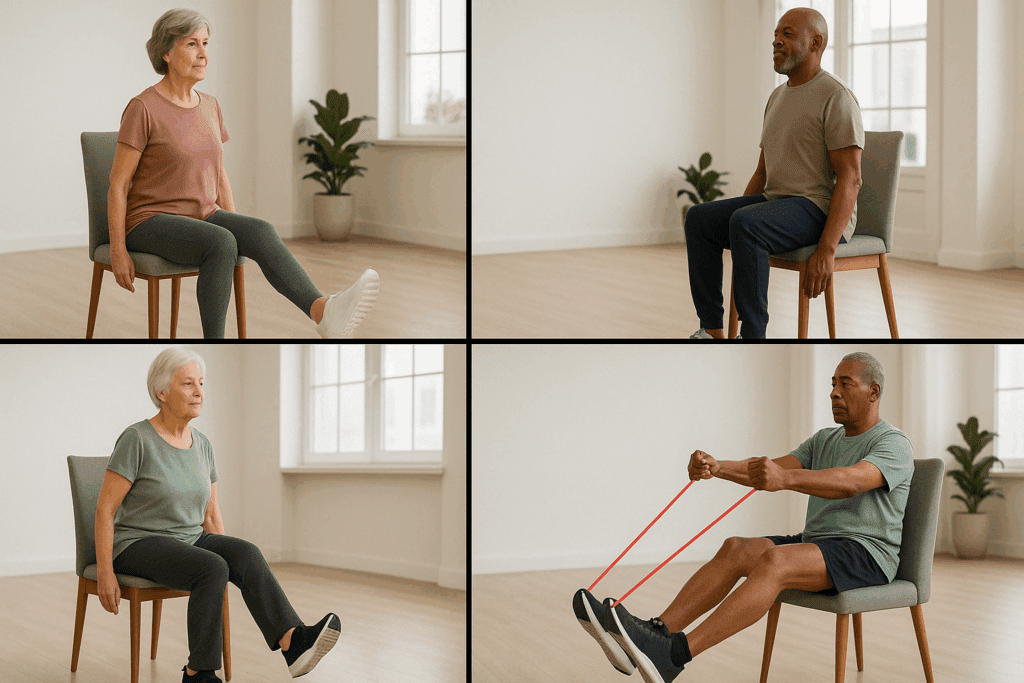
Top Chair Exercises for Arthritic Knees
Several chair-based exercises have been shown to support individuals with knee osteoarthritis or bone-on-bone pain. Among the most effective are straight leg raises, seated knee extensions, heel and toe lifts, seated hamstring curls, and resistance band presses. These exercises focus on key muscle groups that provide structural support to the knee while avoiding undue joint stress.
Straight leg raises involve sitting upright with one foot flat on the ground while the other leg is slowly lifted to a straightened position, held for a few seconds, then lowered. This motion primarily strengthens the quadriceps without requiring knee flexion. Seated knee extensions begin with both feet on the ground; one leg is extended forward until the knee is straight, held briefly, and then lowered with control. This helps enhance knee joint flexibility and endurance.
Heel and toe lifts work the calves and shins by alternately lifting the heels while keeping the toes grounded and vice versa. These movements improve ankle mobility and lower leg strength, both of which are essential for maintaining balance. Seated hamstring curls can be performed by scooting slightly forward in the chair, planting one foot firmly while pulling the other foot back under the chair, engaging the hamstring muscles. Resistance band presses, in which a looped band is placed around the ankles and the foot is pushed forward or sideways against the resistance, can further increase muscular endurance without strain.
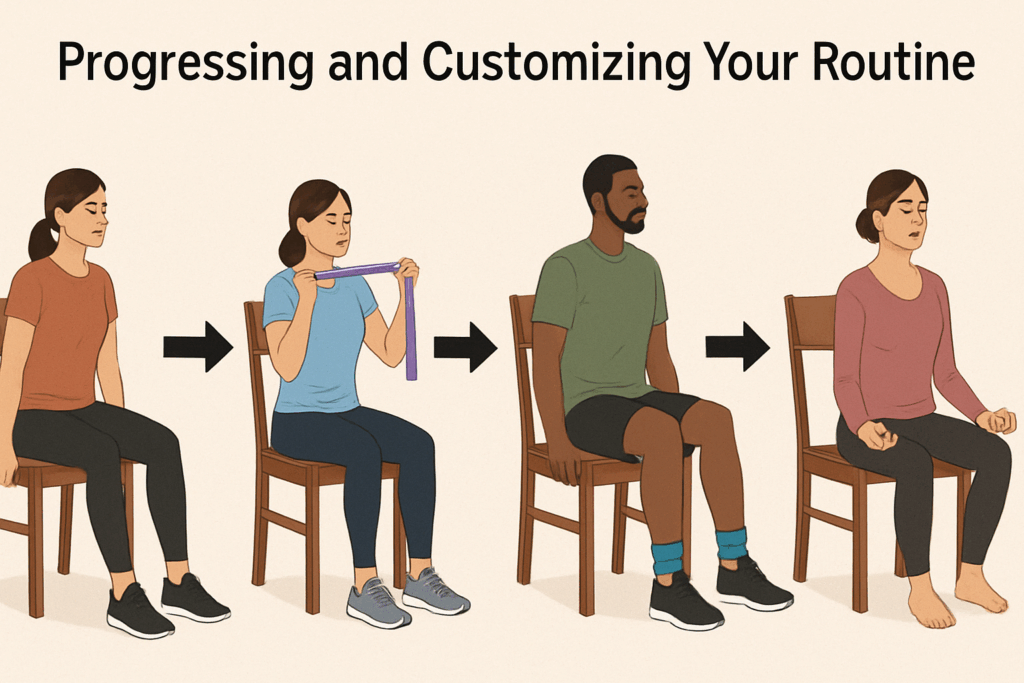
Progressing and Customizing Your Routine
One of the greatest advantages of chair exercises for arthritic knees is their adaptability. As strength and flexibility improve, individuals can gradually increase the number of repetitions, incorporate light resistance bands, or add ankle weights to enhance the challenge. These modifications should be introduced gradually and always with attention to pain levels and fatigue. A typical starting routine may involve 10 to 15 repetitions of each movement, performed two to three times per week, and then increased as tolerated.
To maintain variety and avoid plateaus, it is helpful to rotate through different movements or modify the speed and intensity of the exercises. Slow, controlled movements focus on muscular endurance and joint stability, while slightly faster-paced routines can enhance circulation and cardiovascular fitness. The integration of mindful breathing, visualization techniques, or light music can also make the sessions more enjoyable and meditative, encouraging long-term adherence.
For individuals with more advanced bone-on-bone knee conditions, some exercises may need further modification. For instance, using a resistance ball or folded towel under the knees during leg extensions can reduce pressure and provide comfort. In some cases, seated yoga poses or Pilates-based movements may offer additional benefits, blending strength training with mindful alignment and breath control.
The Role of Consistency in Long-Term Joint Health
Chair exercises offer more than immediate symptom relief. Over time, they contribute significantly to the long-term management of knee osteoarthritis and bone-on-bone pain by supporting musculoskeletal balance. When practiced regularly, these movements can reduce joint stiffness, strengthen the supporting musculature, and prevent further functional decline. Consistency is key, and even modest improvements in strength and flexibility can translate into substantial gains in independence and quality of life.
Studies have demonstrated that regular physical activity, including chair-based routines, can decrease the need for pain medication, improve sleep quality, and even enhance mood and cognitive function in older adults with chronic pain. The psychological benefits of exercise should not be overlooked, as the ability to participate in meaningful daily activities without excessive discomfort can restore a sense of control and self-efficacy that often erodes with chronic joint conditions.
Moreover, consistency with these exercises may delay or reduce the need for more invasive interventions, such as knee replacement surgery. While surgery remains an effective option for many, preserving joint function and minimizing pain through non-invasive strategies should be the first line of defense whenever possible.
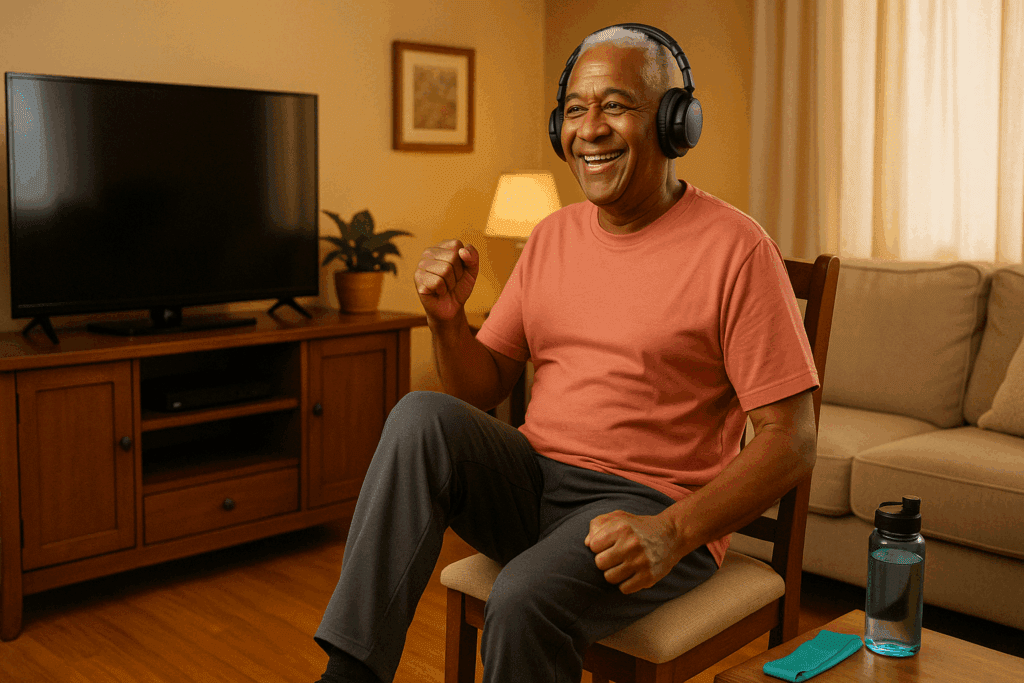
Integrating Chair Exercises Into Daily Life
The true power of chair exercises for arthritic knees lies in their accessibility. These routines can be performed at home, in senior centers, or even at the workplace, making them easy to integrate into daily life. Short sessions—as brief as 10 to 15 minutes—can be effective when performed consistently. The flexibility to exercise while watching television, listening to a podcast, or enjoying a conversation removes many of the barriers associated with more traditional fitness regimens.
Caregivers, physical therapists, and occupational health professionals can also use chair exercises as part of a larger therapeutic program, incorporating them into rehabilitation plans or fall prevention strategies. Because these movements require minimal equipment and can be adapted to a range of ability levels, they are particularly well-suited to community-based health initiatives and group exercise classes for seniors.
For individuals living with mobility limitations, establishing a routine may begin with scheduling specific times each day for exercise, much like any other important appointment. Keeping a journal or using a simple tracking app can reinforce consistency and offer a sense of accomplishment. Even when motivation wanes, remembering the cumulative benefits—reduced pain, better mobility, and enhanced mental clarity—can serve as a compelling reason to continue.
Integrating Chair Exercises into Broader Wellness Goals
Ultimately, the success of any exercise program depends not just on isolated movements but on how well it integrates with a person’s overall lifestyle. Chair exercises can be part of a larger wellness strategy that includes weight management, sleep hygiene, stress reduction, and hydration. For individuals with knee arthritis, maintaining a healthy body weight is especially critical, as each pound of excess weight places approximately four pounds of pressure on the knees during activity.
Sleep quality also influences pain perception and recovery. Establishing a regular sleep routine, reducing screen time before bed, and creating a comfortable sleep environment support physical healing and emotional resilience. Hydration and stress management practices such as deep breathing, journaling, or engaging in enjoyable hobbies contribute to systemic balance and reduce the inflammatory response that drives joint degeneration.
In this context, chair exercises become more than just a way to move—they become a daily ritual of self-care and empowerment. When linked to broader health goals, these movements take on deeper meaning and encourage sustained behavioral change.
Frequently Asked Questions: Advanced Insights Into Chair Exercises for Arthritic Knees and Bone-on-Bone Knee Pain
1. How can chair exercises be adapted for individuals with both knee arthritis and limited hip mobility?
While chair exercises for arthritic knees are primarily designed to protect the knee joint, limited hip mobility can significantly affect performance and comfort. To accommodate both issues, exercises should incorporate a wider base of support and may need to begin with micro-movements to avoid overexertion. Seated pelvic tilts, gentle side-to-side hip shifts, and assisted leg lifts using a towel can reduce strain while promoting circulation and synovial fluid movement. A key strategy is engaging in seated hip mobility drills that focus on slow, controlled activation of stabilizing muscles rather than dynamic stretching. These modifications help ensure that individuals with dual-joint limitations benefit from chair exercises without increasing risk.
2. Are there specific chair-based routines recommended for flare-up days when joint inflammation is higher than usual?
Yes, flare-up days require a more restorative approach. Instead of focusing on strengthening, prioritize gentle mobility and circulation-enhancing exercises. Chair exercises for arthritic knees during flare-ups should avoid resistance and instead emphasize rhythmic, low-amplitude movements such as ankle rolls, gentle toe taps, or seated breathing stretches. These help maintain mobility without provoking further inflammation. Using visualization techniques to mentally rehearse movements can also support neuromuscular continuity even when physical execution is limited. The goal is not intensity but preservation of function and flexibility during high-symptom periods.
3. Can bone on bone knee exercises from a seated position help delay the need for knee replacement surgery?
While surgery may become necessary for some, many orthopedic specialists support the idea that conservative management can delay invasive procedures. Bone on bone knee exercises performed in a chair reduce joint compression while still activating the quadriceps, hamstrings, and glutes—key muscles for knee stabilization. Regular, strategic strengthening combined with improved biomechanics can reduce pain and improve function, possibly postponing or even avoiding surgical intervention. Consistency is crucial; even 15 minutes a day of targeted movement can make a measurable difference over time. Adding balance training or proprioceptive drills while seated can further enhance results.
4. What are the most overlooked muscles that chair exercises can target to improve knee stability?
The deep stabilizers of the hip and core are frequently underutilized in conventional routines. Chair exercises for arthritic knees often emphasize the quadriceps, but targeting the gluteus medius, transverse abdominis, and adductors provides a more comprehensive support system for the knee. Seated isometric contractions, lateral band pushes, and controlled torso rotations engage these stabilizers, promoting balance and joint control. Including these muscles not only improves knee alignment but also reduces strain on compensatory structures like the lower back. A more integrated muscular approach can significantly enhance long-term joint resilience.
5. How do mental health and motivation factor into maintaining a consistent chair exercise routine for chronic knee pain?
Mental health plays a central role in adherence to any physical regimen, particularly when dealing with chronic conditions. Bone on bone knee exercises can feel discouraging if progress is slow or pain flares unpredictably. Setting small, achievable goals and focusing on process rather than outcomes helps build intrinsic motivation. Many individuals benefit from audio-guided sessions that combine movement with affirmations or music, creating a more enjoyable experience. Participation in group virtual classes or journaling progress can foster accountability and a sense of accomplishment that offsets emotional fatigue.
6. Can chair-based programs incorporate progressive overload principles for strength training?
Absolutely. Although often associated with gym-based resistance training, progressive overload can be safely integrated into chair exercises for arthritic knees. This can be done by increasing time under tension, adding resistance bands or ankle weights, or performing exercises at a slower tempo to increase muscular engagement. For example, seated leg extensions can be held for five seconds instead of one to build endurance. Regular reassessment of resistance and range of motion ensures that the exercises continue to challenge the body without compromising safety.
7. How should caregivers assist individuals performing bone on bone knee exercises at home?
Caregivers can play a vital role by creating a safe and supportive environment. They can assist with positioning, provide gentle tactile cues for alignment, and help modify movements when necessary. For bone on bone knee exercises, they may use a pillow to support the joint or help stabilize the foot during movement to reduce pressure. Encouraging hydration, adjusting room temperature, and ensuring good lighting also enhance the comfort and efficacy of chair-based routines. Emotional encouragement and celebrating even small wins help build confidence and consistency in those under their care.
8. Are there cultural or community-based approaches to making chair exercise programs more engaging?
Yes, incorporating culturally relevant music, movement styles, or group dynamics can make chair exercises more inclusive and enjoyable. For example, chair-based dance routines that include traditional rhythms from various cultures can enhance participation and elevate mood. Faith-based communities may also integrate these routines into wellness ministries or spiritual gatherings. These adaptations not only promote physical health but also strengthen social ties, which is essential for emotional well-being among those managing arthritis. Social engagement often improves adherence and can provide an outlet for shared learning and encouragement.
9. How do chair exercises complement aquatic therapy or other low-impact regimens?
Chair exercises for arthritic knees serve as an excellent complement to aquatic therapy because both modalities emphasize joint protection and controlled movement. While aquatic therapy provides buoyancy and resistance in a vertical plane, chair exercises allow for more targeted muscular engagement in a seated posture. This combination enhances functional carryover to daily activities, such as standing, walking, and transitioning between surfaces. Performing chair exercises on non-pool days helps reinforce neuromuscular adaptations developed during aquatic sessions. Together, they provide a well-rounded therapeutic approach for managing chronic knee pain.
10. What future innovations could shape the way we approach seated exercise for arthritic conditions?
Emerging technologies such as smart chairs equipped with motion sensors or feedback systems could revolutionize chair-based exercise programs. These devices may provide real-time feedback on form, track progress, and adapt difficulty based on user input. Virtual reality platforms designed for seated movement could offer immersive rehabilitation experiences for those with bone on bone knee pain. Additionally, machine learning algorithms might eventually tailor bone on bone knee exercises to each individual’s biomechanics and recovery profile. These advances promise to enhance precision, engagement, and outcomes for individuals managing knee osteoarthritis through seated routines.
Conclusion : Restoring Strength and Confidence Through Chair-Based Movement
For those living with the challenges of arthritic knees or bone-on-bone knee pain, the journey toward better mobility and reduced discomfort may feel overwhelming at times. However, the evidence is clear: movement, when approached mindfully and safely, is one of the most powerful tools available for joint health. Chair exercises for arthritic knees offer a gentle yet effective way to build strength, enhance flexibility, and maintain independence without risking further injury. These low-impact routines allow individuals to take control of their health in an empowering and accessible manner, regardless of age or mobility level.
By incorporating chair exercises into a regular wellness routine, individuals not only support the physical structures surrounding the knee but also nurture the emotional resilience needed to live fully despite chronic conditions. Whether you are newly diagnosed or have been managing bone-on-bone knee pain for years, it’s never too late to benefit from this therapeutic approach. Through consistency, education, and the willingness to adapt, chair-based movement can restore not just physical function, but a sense of confidence and agency in everyday life.
Ultimately, the most effective bone on bone knee exercises are those that are sustainable, safe, and grounded in an understanding of each person’s unique needs. With proper guidance and a commitment to regular practice, these simple seated movements can become a cornerstone of holistic joint care, offering comfort, stability, and renewed hope for the future.

